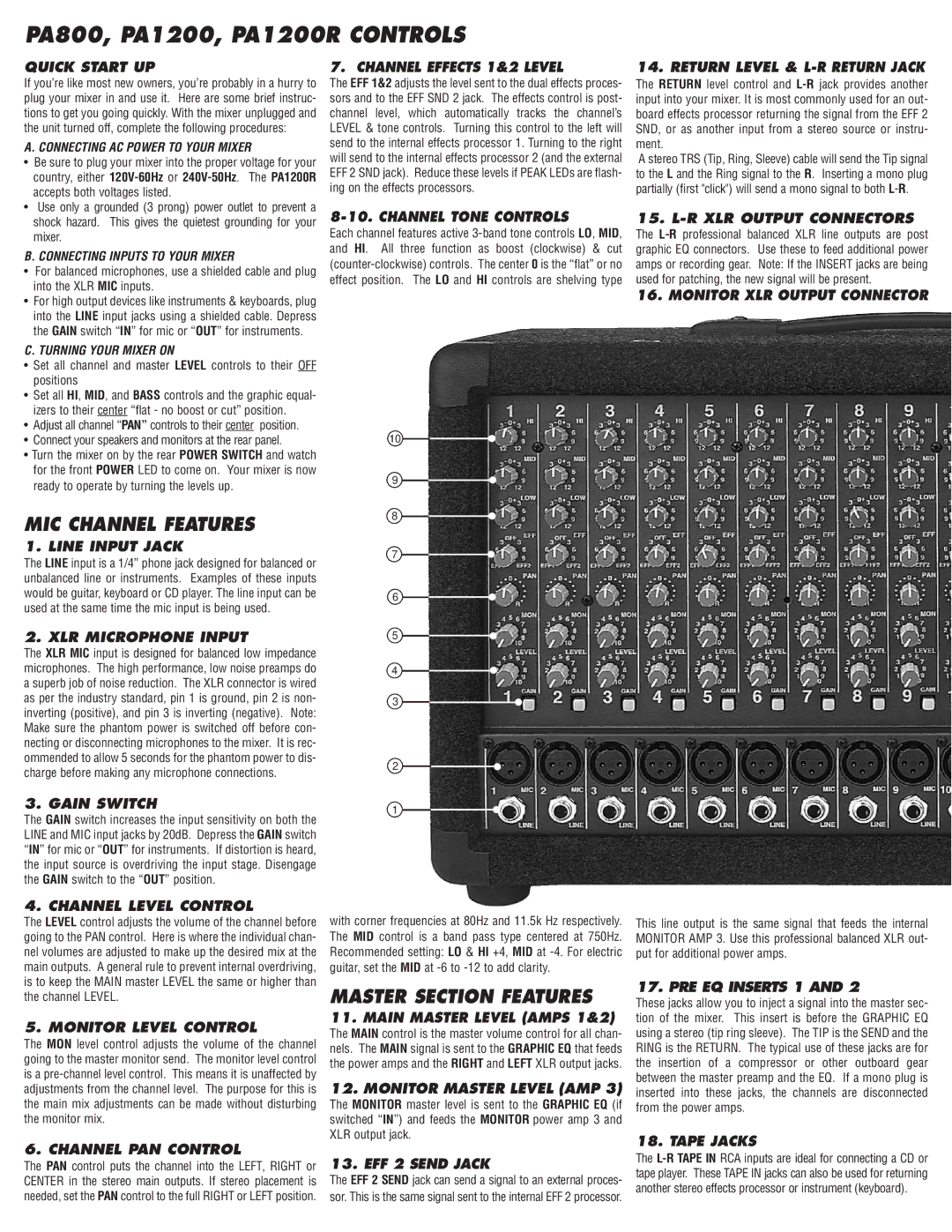
PA800, PA1200, PA1200R CONTROLS
QUICK START UP
If you’re like most new owners, you’re probably in a hurry to plug your mixer in and use it. Here are some brief instruc- tions to get you going quickly. With the mixer unplugged and the unit turned off, complete the following procedures:
A. CONNECTING AC POWER TO YOUR MIXER
•Be sure to plug your mixer into the proper voltage for your country, either
•Use only a grounded (3 prong) power outlet to prevent a shock hazard. This gives the quietest grounding for your mixer.
B. CONNECTING INPUTS TO YOUR MIXER
•For balanced microphones, use a shielded cable and plug into the XLR MIC inputs.
•For high output devices like instruments & keyboards, plug into the LINE input jacks using a shielded cable. Depress the GAIN switch “IN” for mic or “OUT” for instruments.
C. TURNING YOUR MIXER ON
•Set all channel and master LEVEL controls to their OFF positions
•Set all HI, MID, and BASS controls and the graphic equal- izers to their center “flat - no boost or cut” position.
•Adjust all channel “PAN” controls to their center position.
•Connect your speakers and monitors at the rear panel.
•Turn the mixer on by the rear POWER SWITCH and watch for the front POWER LED to come on. Your mixer is now ready to operate by turning the levels up.
MIC CHANNEL FEATURES
1. LINE INPUT JACK
The LINE input is a 1/4” phone jack designed for balanced or unbalanced line or instruments. Examples of these inputs would be guitar, keyboard or CD player. The line input can be used at the same time the mic input is being used.
2. XLR MICROPHONE INPUT
The XLR MIC input is designed for balanced low impedance microphones. The high performance, low noise preamps do a superb job of noise reduction. The XLR connector is wired as per the industry standard, pin 1 is ground, pin 2 is non- inverting (positive), and pin 3 is inverting (negative). Note: Make sure the phantom power is switched off before con- necting or disconnecting microphones to the mixer. It is rec- ommended to allow 5 seconds for the phantom power to dis- charge before making any microphone connections.
3. GAIN SWITCH
The GAIN switch increases the input sensitivity on both the LINE and MIC input jacks by 20dB. Depress the GAIN switch “IN” for mic or “OUT” for instruments. If distortion is heard, the input source is overdriving the input stage. Disengage the GAIN switch to the “OUT” position.
4. CHANNEL LEVEL CONTROL
The LEVEL control adjusts the volume of the channel before going to the PAN control. Here is where the individual chan- nel volumes are adjusted to make up the desired mix at the main outputs. A general rule to prevent internal overdriving, is to keep the MAIN master LEVEL the same or higher than the channel LEVEL.
5. MONITOR LEVEL CONTROL
The MON level control adjusts the volume of the channel going to the master monitor send. The monitor level control is a
7. CHANNEL EFFECTS 1&2 LEVEL
The EFF 1&2 adjusts the level sent to the dual effects proces- sors and to the EFF SND 2 jack. The effects control is post- channel level, which automatically tracks the channel’s LEVEL & tone controls. Turning this control to the left will send to the internal effects processor 1. Turning to the right will send to the internal effects processor 2 (and the external EFF 2 SND jack). Reduce these levels if PEAK LEDs are flash- ing on the effects processors.
8-10. CHANNEL TONE CONTROLS
Each channel features active
10
9
8
7
6
5
4
3
2
1
with corner frequencies at 80Hz and 11.5k Hz respectively. The MID control is a band pass type centered at 750Hz. Recommended setting: LO & HI +4, MID at
MASTER SECTION FEATURES
11.MAIN MASTER LEVEL (AMPS 1&2)
The MAIN control is the master volume control for all chan- nels. The MAIN signal is sent to the GRAPHIC EQ that feeds the power amps and the RIGHT and LEFT XLR output jacks.
12.MONITOR MASTER LEVEL (AMP 3)
The MONITOR master level is sent to the GRAPHIC EQ (if switched “IN”) and feeds the MONITOR power amp 3 and XLR output jack.
14.RETURN LEVEL & L-R RETURN JACK
The RETURN level control and
A stereo TRS (Tip, Ring, Sleeve) cable will send the Tip signal to the L and the Ring signal to the R. Inserting a mono plug partially (first "click") will send a mono signal to both
15.L-R XLR OUTPUT CONNECTORS
The
16.MONITOR XLR OUTPUT CONNECTOR
This line output is the same signal that feeds the internal MONITOR AMP 3. Use this professional balanced XLR out- put for additional power amps.
17. PRE EQ INSERTS 1 AND 2
These jacks allow you to inject a signal into the master sec- tion of the mixer. This insert is before the GRAPHIC EQ using a stereo (tip ring sleeve). The TIP is the SEND and the RING is the RETURN. The typical use of these jacks are for the insertion of a compressor or other outboard gear between the master preamp and the EQ. If a mono plug is inserted into these jacks, the channels are disconnected from the power amps.
18. TAPE JACKS
6. CHANNEL PAN CONTROL
The PAN control puts the channel into the LEFT, RIGHT or | 13. EFF 2 SEND JACK |
CENTER in the stereo main outputs. If stereo placement is | The EFF 2 SEND jack can send a signal to an external proces- |
needed, set the PAN control to the full RIGHT or LEFT position. | sor. This is the same signal sent to the internal EFF 2 processor. |
The
